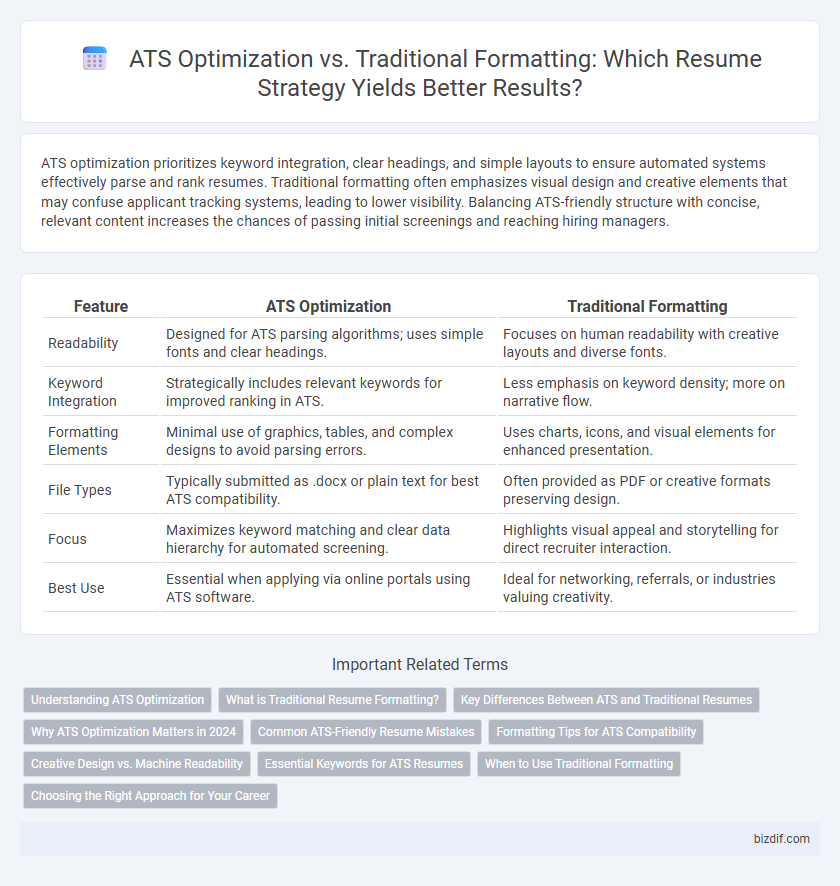ATS optimization prioritizes keyword integration, clear headings, and simple layouts to ensure automated systems effectively parse and rank resumes. Traditional formatting often emphasizes visual design and creative elements that may confuse applicant tracking systems, leading to lower visibility. Balancing ATS-friendly structure with concise, relevant content increases the chances of passing initial screenings and reaching hiring managers.
Table of Comparison
| Feature | ATS Optimization | Traditional Formatting |
|---|---|---|
| Readability | Designed for ATS parsing algorithms; uses simple fonts and clear headings. | Focuses on human readability with creative layouts and diverse fonts. |
| Keyword Integration | Strategically includes relevant keywords for improved ranking in ATS. | Less emphasis on keyword density; more on narrative flow. |
| Formatting Elements | Minimal use of graphics, tables, and complex designs to avoid parsing errors. | Uses charts, icons, and visual elements for enhanced presentation. |
| File Types | Typically submitted as .docx or plain text for best ATS compatibility. | Often provided as PDF or creative formats preserving design. |
| Focus | Maximizes keyword matching and clear data hierarchy for automated screening. | Highlights visual appeal and storytelling for direct recruiter interaction. |
| Best Use | Essential when applying via online portals using ATS software. | Ideal for networking, referrals, or industries valuing creativity. |
Understanding ATS Optimization
ATS optimization involves structuring resumes with specific keywords, standard fonts, and clear headings to ensure accurate parsing by Applicant Tracking Systems. Unlike traditional formatting, which may prioritize visual appeal, ATS-friendly resumes emphasize readability and keyword relevance to improve the chances of passing automated screening. Understanding ATS optimization enables job seekers to align their content with algorithmic criteria, increasing visibility in digital recruitment processes.
What is Traditional Resume Formatting?
Traditional resume formatting emphasizes a visually appealing layout with customized fonts, colors, and design elements that highlight creativity and style. It often includes sections like objectives, summaries, and detailed job descriptions but may lack standardized keywords essential for ATS recognition. This approach prioritizes human reviewers' preferences over algorithm-friendly structures, which can limit visibility in automated applicant tracking systems.
Key Differences Between ATS and Traditional Resumes
ATS optimization prioritizes keyword integration and simple formatting to ensure resumes are accurately parsed by applicant tracking systems, avoiding complex designs, images, or unconventional fonts. Traditional formatting emphasizes visual appeal and creative layouts, which can confuse ATS software and lead to missed information during automated screening. Understanding these key differences helps job seekers create resumes that both pass electronic filters and appeal to human recruiters.
Why ATS Optimization Matters in 2024
ATS optimization matters in 2024 because over 98% of large companies use Applicant Tracking Systems to filter resumes, making traditional formatting obsolete for job seekers aiming to pass initial screenings. An ATS-optimized resume uses clear, relevant keywords and simple layouts to ensure accurate parsing and higher ranking in search results. Ignoring ATS standards risks resumes being overlooked regardless of qualifications, significantly reducing interview opportunities.
Common ATS-Friendly Resume Mistakes
Common ATS-friendly resume mistakes include using complex layouts, graphics, and images that ATS cannot read, leading to parsing errors. Overusing keywords without context or incorporating unusual fonts and headers can cause important information to be missed by the system. Proper ATS optimization requires simple formatting, standard fonts, and keyword integration that aligns naturally with the job description to improve readability and ranking.
Formatting Tips for ATS Compatibility
Use simple formatting with standard fonts like Arial or Times New Roman and avoid graphics, tables, or complex layouts that ATS software cannot parse. Incorporate clear section headings such as "Work Experience" and "Education" using consistent, easy-to-read formatting to enhance keyword recognition. Save the resume as a Word document or plain text file, as these formats ensure optimal compatibility with most applicant tracking systems.
Creative Design vs. Machine Readability
ATS optimization prioritizes machine readability by using simple fonts, standard headings, and keyword-rich content to ensure resumes pass automated screenings. Traditional formatting often emphasizes creative design with graphics and unconventional layouts that can confuse ATS algorithms, risking rejection. Balancing creativity with ATS-friendly structures enhances visibility while maintaining professional appeal.
Essential Keywords for ATS Resumes
Essential keywords are critical for ATS optimization as they enable applicant tracking systems to recognize relevant skills and qualifications, significantly increasing the chances of passing the initial screening. Traditional formatting often emphasizes visual appeal but may lack the strategic placement of keywords that ATS algorithms require to accurately parse and rank resumes. Incorporating industry-specific jargon, action verbs, and role-specific terms ensures that the resume content aligns with job descriptions and improves compatibility with ATS software.
When to Use Traditional Formatting
Traditional formatting remains essential when applying for creative roles or industries valuing design and visual appeal over automated screening, such as graphic design or marketing. Use traditional formats when submitting directly to a hiring manager who appreciates personalized resumes with unique layouts. This approach highlights creativity and individuality, which may be obscured by ATS optimization strictures.
Choosing the Right Approach for Your Career
Selecting the right resume format depends on your career goals and industry standards. ATS-optimized resumes use keyword-rich content and simple layouts to pass automated screening systems, increasing your chances in competitive job markets. Traditional formatting emphasizes visual appeal and design, which may be ideal for creative roles but risks rejection by Applicant Tracking Systems in corporate environments.
ATS Optimization vs Traditional Formatting Infographic

 bizdif.com
bizdif.com